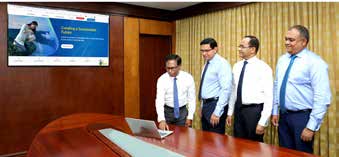Keyword search
My Report
The Bank’s Business Model, designed for Sustainable Value Creation, is rooted in its Sustainability Framework (Figure 10). This framework embodies a 3-pillar approach to sustainability, encompassing the Bank’s enduring viability as well as its commitment to societal and environmental well-being. This integrated strategy intertwines the Bank's sustainability as an ongoing enterprise with its responsibility towards the society and the environment.
The Bank has established a robust organisational structure led by the Executive Sustainability Committee which is supported by the Sustainability Working Committee with Board oversight to uphold ESG principles and undertake sustainability initiatives to ensure alignment with regulatory standards and the Central Bank’s Sustainable Finance Roadmap, as detailed later in this section. Additionally, the Bank promotes sustainability internally through distribution of educational materials and conducting workshops to cultivate a culture of responsible behaviour among staff.

Commercial Bank unveiled evolved logo, fusing blue with green to embody its holistic commitment to sustainability

Commercial Bank proudly became the first corporate entity in Sri Lanka to introduce a green element to its corporate identity. It mirrors the Bank’s strong commitment and the sincere dedication to sustainability, spanning diversity, social equity, inclusivity, good governance, transparency, accountability and eco-friendly financial solutions. This strategic initiative is expected to enhance the Bank's image and solidify its position as a forward-thinking institution dedicated to making a positive impact on Environment, Society and Governance (ESG).


With a strategic approach to sustainability across the three key pillars – Sustainable Banking, Responsible Organisation and Community Engagement – the Bank ensures holistic consideration of economic, social and environmental factors, fostering the best interests of all stakeholders at all times.
ESG and wider sustainability credentials
Demonstrating a strong commitment to ESG principles and wider sustainability initiatives, the Bank has established a robust organisational structure to guide, drive and oversee sustainability initiatives and compliance with regulatory standards. At the helm is the Executive Sustainability Committee, which convenes quarterly to ensure alignment with the Central Bank’s Sustainable Finance Roadmap and other regulatory directives. This Committee oversees the implementation of sustainability principles throughout the Bank. Supporting this Committee is the Sustainability Working Committee (SWC), tasked with deliberating on and recommending sustainability initiatives. The SWC assesses proposed activities, evaluates their impact and identifies associated risks, ensuring alignment with broader sustainability objectives.
The Bank has accordingly integrated ESG considerations into its products, develops strategies for ESG risk management and discloses environmental and social impacts. It actively participates in international cooperation platforms, sharing knowledge and mobilising resources. The Bank’s comprehensive reporting, aligned with Global Reporting Initiative (GRI) standards, showcases its contribution to the UN SDGs. It engages in initiatives such as mangrove replanting, planting 100,000 trees islandwide, reforestation and coral restoration, while promoting paperless banking and installing solar power at branches. The Bank’s credit policy and lending guidelines emphasise responsible lending and minimising environmental risks. During the year, the Bank implemented a Board-approved Green Financing Policy. These efforts have earned the Bank numerous awards and recognition for its ESG and sustainability credentials, which included Best Bank for Environmental, Social and Governance (ESG) Sri Lanka 2023 by Global Business Review Magazine, UAE and highly recommended – Best ESG Offering by Private Banker International Global Wealth Awards 2023, Singapore for Sustainable initiatives carbon neutral bank road map and paperless banking initiatives.
Additionally, internal communication efforts, facilitated through platforms like ComPulse, disseminate educational materials on responsible and sustainable behaviours to staff members. Workshops on 4R (Reduce, Reuse, Recycle and Recover) and Circular Economy concepts further enhance staff understanding and engagement with sustainability practices. Through these structures and initiatives, the Bank fosters a culture of sustainability within its operations.
Financial intermediation and maturity transformation
Leveraging the Bank’s strengths for long term value creation, its resilient business model centers on two primary activities: financial intermediation and maturity transformation.
Financial intermediation involves acting as a bridge between stakeholders—especially depositors and borrowers—converting deposits into investments and assets. Meanwhile, maturity transformation focuses on transforming short-term funds into long-term lending and investments. Effectively allocating financial resources for these activities is crucial for the country’s overall economic growth.
These activities harness resources from various capital sources including Financial, Manufactured, Intellectual, Human, Social and Relationship and Natural capitals.
Figure 11 below depicts these six capitals, followed by a brief narrative of each.

These resources are then transformed into outputs, resulting in outcomes that benefit the stakeholders who contribute and own these capital inputs. One of the content elements in an integrated report as per the International Integrated Reporting Framework is the disclosure of the business model. Accordingly, given below is a narrative guide to the visual depiction of the Business Model (Figure 12 on pages 58 and 59) and the Statement of Capital Position (Table 07 on pages 60 and 61).
Stakeholders fuel the Bank's operations, providing essential resources termed as “capitals” within the Business Model (Figure 12 on pages 58 and 59). Beyond financial capital, these inputs encompass institutional knowledge, brand equity and robust stakeholder relationships often labeled as “off-balance sheet” or “hidden” capitals. These inputs are actively leveraged, capitalising on them to produce outputs key products and services and valuable outcomes for both the Bank and its stakeholders. This dynamic process, depicted in the Business Model, illustrates constant capital circulation and ongoing value creation, captured within this Integrated Report for the year 2023. The Statement of Capital Position provides a snapshot of the Bank's capital status, highlighting various indicators under each capital.
Statement of capital position
The Bank’s actions in advancing financial intermediation and maturity transformation, along with the ensuing interactions among capitals, fortify these capitals and reflect the year's value creation, evident in the Bank’s Statement of Capital Position at the start and the end of 2023 (Table 07).
Two primary income streams – net interest income from fund-based operations and fee and commission income from fee-based operations – boost the Bank’s financial capital. The process of delivering value to and deriving value from various stakeholders also elevates other capitals. In fund-based operations, money is mobilised from depositors and other external sources for lending and investment, generating interest income and costs. The resultant net interest income compensates the Bank for credit, funding and interest rate risks. The Bank generated 70.36% of its total operating income from net interest income in 2023 (2022 – 61.51%). Fee-based operations, encompassing all other services provided by the Bank, generated the remaining 29.64% of the total operating income (2022 – 38.49%). Showcasing efficient financial intermediation, the Bank grew its deposit base by 8.92%, the lending portfolio by 3.76% and fee and commission income by 16.65% during the year under review.
Gearing
Financial intermediation and maturity transformation distinguish the Bank's business model from typical corporations. As a commercial bank relying mostly on customer deposits for funding, the Bank employs gearing to compensate for the comparatively lower Return on Assets (ROA) and meet acceptable Return on Equity (ROE) targets for investors. Gearing involves expanding business scope by increasing deposits, securing additional funding and leveraging these resources through lending or investments to amplify the loan book and investment portfolios based on existing capital.
This strategy, fundamental in banking, enables handling business volumes nearly 10 times greater than available equity, primarily fueled by the ability to mobilise deposits from the public. However, gearing poses multiple internal and external risks, accentuated by emerging global shifts potentially disrupting this model. The Bank, as outlined in this Annual Report, has established robust risk governance and management frameworks, overseen by the Board, effectively navigating and mitigating such risks.
For an in-depth understanding of the Bank’s capital, risk-weighted assets and Capital Adequacy Ratios, refer to Annex 2 Basel III – Disclosures under Pillar III as per the Banking Act Direction No. 1 of 2016.
Stakeholder returns
As illustrated in Table 07 within the Statement of Capital Position, the Bank has consistently enhanced profitability while prudently managing gearing levels. This profitability mirrors the net impact of value creation for stakeholders-reflecting in investor returns through earnings, dividends and share price appreciation. Ending 2023 with the highest market capitalisation among banking institutions and ninth among all CSE-listed companies, the Bank’s Investor Relations section details its shares’ performance.
As an established regional bank, the Bank is actively seeking opportunities for inorganic growth and regional expansion, while aiming for organic growth in Sri Lanka, Bangladesh, the Maldives and Myanmar. The exclusive long-term bancassurance partnership the Bank entered into with AIA during the year, which will enable the Bank to draw on AIA’s best in class capabilities and AIA to leverage the Bank’s meaningful connections with the local communities is a case in point. Such strategic moves aim to diversify risk exposure and revenue streams, strengthening operational sustainability and long-term value creation.
